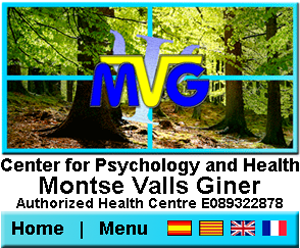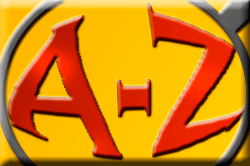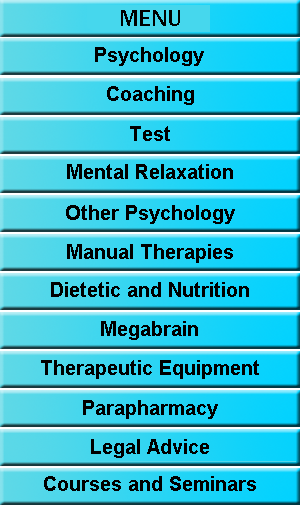

From these pages, our center provides you with a description of the symptoms of the most common diseases and disorders of the mind. Know that this relationship is purely informational and should under no circumstances be used for diagnostic, as this mission is optional, only, duly qualified professionals.
To make it easier to use, this relationship is sorted alphabetically. If you know the name of the disorder or disease that interests you, click on the letter that its name starts, in the following menu to go to the page that contains it.
| A (to Anorexia) |
Or if you prefer, directly looking for the name, you're interested in the alphabetical list of all the disorders or diseases that we see in this glossary, we offer you below:
EROTIC ASPHYXIATION (KOTZWARA'S SYNDROME)
EXPLOSIVE PERSONALITY DISORDER
HISTRIONIC PERSONALITY DISORDER
|
INITIAL |
|
Name |
|
Characteristics and Symptoms |
|
It is a rhythm disturbance
of thought consisting of the repetition speculate what the
interviewer says. It is a way in which verbigeration
repeated immediately and automatically, you just heard. |
|
Habitual Treatment |
|
The treatment, is psychiatric and pharmacologic. |
|
Name |
|
Characteristics and Symptoms |
|
The patient, be depressed
and there may come a time when all activity is suspended. It
is often difficult to answer the questions put to him. It is
also known as major depression. |
|
Habitual Treatment |
|
The treatment, is psychiatric and pharmacologic antidepressant and bipolar with lithium salts. Detention may be necessary in some cases. In cases of suicide risk and in very deep tables can be used electroshocks. |
|
Name |
|
Characteristics and Symptoms |
|
When a child over 4 or 5
years, still wetting the bed at night, we can consider that
this condition exists. It is usually more common in boys
than in girls. |
|
Habitual Treatment |
|
The most common treatment, is the psychological therapy |
|
Name |
|
Characteristics and Symptoms |
|
It is a way of speaking pompous and mannered, usually seen in schizophrenic disorders. |
|
Habitual Treatment |
|
The treatment, is psychiatric and pharmacologic. |
|
Name |
|
Characteristics and Symptoms |
|
Habitual Treatment |
|
|
|
Name |
|
Characteristics and Symptoms |
|
Epileptic seizures are caused by nerve disease and manifest as convulsions and disturbance or loss of sense. |
|
Habitual Treatment |
|
The treatment is neurologic and pharmacologic and in some cases surgical. |
|
Name |
|
Characteristics and Symptoms |
|
Is the lack of erection due
to anxiety. |
|
Habitual Treatment |
|
Once discarded organic problems, the best thing to treat erectile dysfunction are psychological and / or sexological therapies |
|
Name |
|
Characteristics and Symptoms |
|
It is a disorder of sexual behavior, where pleasure is obtained by erotic asphyxiation. This practice is really dangerous and in some cases, deaths have been reported, in practice, such as the Czech composer Frantizek Kotzwara, who was killed in 1791 by practicing. This syndrome is named after the composer since the first case was recorded. |
|
Habitual Treatment |
|
The treatment is psychiatric |
|
Name |
|
Characteristics and Symptoms |
|
This disorder of sexual
behavior, is to obtain sexual pleasure, through the
exhibition of the sexual organ of a person of the opposite
sex in public places, or unexpectedly. |
|
Habitual Treatment |
|
The treatment is psychiatric and / or psychological. |
|
Name |
|
Characteristics and Symptoms |
|
Also known as reactive, is
less intense than endogenous depression and is a result of
the response to certain external stimuli. Sadness is not as
intense. There is concern but the ideas are not so black.
The depressing effect is accompanied by anxiety. Insomnia,
if any, is first-time or frequent waking. |
|
Habitual Treatment |
|
The best results in the treatment, is obtained with psychological therapies. Can not find efficiency in the use of antidepressants and electroshock, no effect. |
|
Name |
|
Characteristics and Symptoms |
|
It is the one produced by external factors, physical, chemical or biological attacks the central nervous system (such as meningitis disease, hyperthyroidism, atherosclerosis, infectious diseases, poisoning by narcotics, drinking, toxic for professional use, brain tumors, etc.). They are divided into two groups: Symptomatic (in which the brain has altered its functionality but architecture There is no malfunction, but no injuries) and organic (The brain has an injury, damaged tissue). |
|
Habitual Treatment |
|
The treatment can be, depending on the source, psychiatric, neurological and / or medical. |
|
Name |
|
Characteristics and Symptoms |
|
It is included in personality disorders and is characterized by states of anger and irritability. |
|
Habitual Treatment |
|
Psychiatric and / or psychological treatment. |
|
INITIAL |
|
Name |
|
Characteristics and Symptoms |
|
It is the ultimate
expression of decreased facial expression. |
|
Habitual Treatment |
|
The treatment, is neurologic and/or psychiatric and pharmacologic and usually requires hospitalization. |
|
Name |
|
Characteristics and Symptoms |
|
The person suffering from this disorder of sexual behavior, gets sexual pleasure by rubbing her genitals with bodies of the other sex, in situations of agglomeration, such as public transport at rush hour. |
|
Habitual Treatment |
|
Psychiatric and / or psychological treatment. |
|
Name |
|
Characteristics and Symptoms |
|
The disorder of thought content, is that due to an acceleration thereof, a lack of logical connection between the different ideas occurs. This leads to cause the appearance of a seemingly incoherent speech, because although the associative logic, is the normal acceleration causes the language is incomprehensible. This flight of ideas, can be of different phrases and with effort, you can sometimes get to grasp the meaning. |
|
Habitual Treatment |
|
The treatment, is psychiatric and pharmacologic |
|
INITIAL |
|
Name |
|
GRANDEUR DELUSIONAL IDEAS |
|
Characteristics and Symptoms |
|
Delusional ideas of grandeur are those in which the patient thinks he is a great character, with great powers of body transformation. Think I could reduce the body. |
|
Habitual Treatment |
|
The treatment, is psychiatric and pharmacologic. |
|
Name |
|
Characteristics and Symptoms |
|
This disorder is a disorder of sexual behavior, sexual pleasure which is obtained by observation or physical interaction with elderly. |
|
Habitual Treatment |
|
Psychiatric treatment. |
|
INITIAL |
|
Name |
|
Characteristics and Symptoms |
|
The hallucinations consist
of the perception of nonexistent objects. |
|
Habitual Treatment |
|
The treatment will be neurological, psychiatric or neuropsychiatric. |
|
Name |
|
Characteristics and Symptoms |
|
For induced hallucinations, which are understood as the result from sensory deprivation. If there any sense deprivation, it is common hallucinations occur. For example a person who have operated the view and should lead blindfolded for some time, may suffer visual hallucinatory phenomena. |
|
Habitual Treatment |
|
In cases where necessary, the treatment will be neurological, psychiatric or neuropsychiatric. |
|
Name |
|
Characteristics and Symptoms |
|
The presence hallucinations
consist of "see" a person or object, out of sight (ex.
behind) or in the perception of an object or person through
a channel that is not right. For example having the feeling
of seeing by foot or "see" smells, or "hear" flavors. |
|
Habitual Treatment |
|
The treatment, is psychiatric and pharmacologic in the most part of cases. |
|
Name |
|
Characteristics and Symptoms |
|
This delusional disorder,
meets only two of the rules of hallucinations, for example
smell something that looks authentic, so it meets with the
external perception. Also fulfills the second condition,
since there is no real object. But you miss the third, since
the subject knows it is not real, is aware of his illness. |
|
Habitual Treatment |
|
Usually solved by psychiatric or neuropsychiatric treatment. |
|
Name |
|
Characteristics and Symptoms |
|
The schizophrenia are
chronic psychotic illnesses. The sufferer, is often unaware
of their disease and lose the universal logic of things. |
|
Habitual Treatment |
|
Psychiatric and pharmacologic treatment and in some cases electroshock. Usually with very poor results. |
|
Name |
|
Characteristics and Symptoms |
|
It is a disorder in the group of agnosia, where the affected due to a brain injury, is prevented for a part of the visual field, but is aware of it and corrected by head turning. |
|
Habitual Treatment |
|
Treatment is neurological |
|
Name |
|
Characteristics and Symptoms |
|
It is an affection in agnosia, where the sufferer ceases to be aware of a part of your body, usually the left, with injuries to the right side of the brain. Not capture the sensitivity of this part and are not aware of it. |
|
Habitual Treatment |
|
Treatment is neurological. |
|
Name |
|
Characteristics and Symptoms |
|
It is included in personality disorders and is characterized by the states of overacting to get attention, like those of hysterical neurosis |
|
Habitual Treatment |
|
Psychiatric and / or psychological treatment. |
|
Name |
|
Characteristics and Symptoms |
|
It is a pathological increase of memory. So excessive increases the ability to store (record, retain, recall). Usually it is associated with other disorders or diseases (manic disorders, obsessive disorders, mental weakness, etc.) |
|
Habitual Treatment |
|
Treatment is neurological |
|
Name |
|
Characteristics and Symptoms |
|
It is a psychomotor disorder
in which the affected tends to produce a lot of gestures,
grimaces, which vary throughout the conversation. |
|
Habitual Treatment |
|
Psychiatric treatment. |
|
Name |
|
Characteristics and Symptoms |
|
It is a condition of
increased attention. Those affected are set to all the
stimuli that come to them, but this leads them to poor
performance and a state of low attention, for they try to be
aware of everything at once. |
|
Habitual Treatment |
|
The treatment, is psychiatric and pharmacologic. |
|
Name |
|
Characteristics and Symptoms |
|
It is a pathological increase of sexual appetite, which may be associated with schizophrenia, mania or by consumption of toxic. |
|
Habitual Treatment |
|
Psychiatric treatment |
|
Name |
|
Characteristics and Symptoms |
|
It consists of, pathological excessive sleepiness. There are too drowsy wakefulness and requires many hours of sleep. They may be secondary (those that result from trauma, tumors, encephalitis, hypothyroidism, etc.) and where the only sign primary or most prominent, is the same drowsiness. |
|
Habitual Treatment |
|
The treatment may be medical, neuronal or psychiatric depending on the type of hypersomnia. |
|
Name |
|
Characteristics and Symptoms |
|
It is a pathological decrease in facial expression. It usually occurs in endogenous depression, schizophrenia and dementia. |
|
Habitual Treatment |
|
Psychiatric and / or neurologic treatment. |
|
Name |
|
Characteristics and Symptoms |
|
It is a condition of
decreased attention. Those affected have a hard time paying
attention to things and as a result is associated with
memory deficits. |
|
Habitual Treatment |
|
The treatment is set according to the cause of the disorder, which may be neurological or psychiatric and pharmacologic |
|
Name |
|
Characteristics and Symptoms |
|
It is the loss of desire and sex drive. It manifests itself in neurotic, depressive and some schizophrenia. |
|
Habitual Treatment |
|
Psychiatric treatment. |
|
Name |
|
Characteristics and Symptoms |
|
Hysteria is a type of neurosis, which usually occurs in immature or emotionally unstable people, low frustration tolerance. Frustration leads to anger them, anxiety, irritability. In response to this frustration the patient tends to manipulate people who have been convicted of the alleged frustration. They can invent diseases as paralysis of the legs or arms, loss of speech, epileptic crises appear, vision loss, etc. These symptoms begin to appear when secondary benefits are obtained, as increased attention, better treatment. The patient is acting unconsciously, will not put in all this, just have a psychological inability to get best resources and then uses this "action", but that is absolutely not deliberate or controllable. |
|
Habitual Treatment |
|
The best results are obtained by psychological therapy. |
|
Name |
|
Characteristics and Symptoms |
|
The symptoms of hysteria are not only physical but also mental. If symptoms is within the somatic line, it would then of conversion hysteria |
|
Habitual Treatment |
|
Treatment is by psychological therapy, but may also require psychiatric treatment |
|
Name |
|
Characteristics and Symptoms |
|
The symptoms of hysteria are not only physical but also mental. If the symptoms are within the mental line, then it would be Dissociation of Hysteria |
|
Habitual Treatment |
|
Treatment is by psychological therapy, but may also require psychiatric treatment |

Consulting of Psychology and Health Montse Valls Giner
Powered by Monvall.com